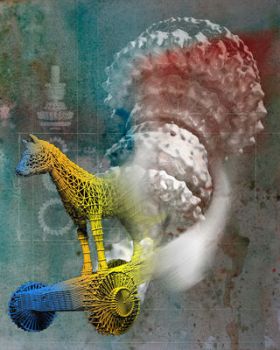Dec 10 2013
When attacking body cells, bacteria, such as salmonellae or Yersinia (plague pathogens), inject specific bacterial proteins through hollow, syringe-like structures – called injectisomes – into the host cells. These substances reprogram the cells and can thus overcome their defense. From then on, they can infiltrate the cells unhindered in large numbers, and trigger diseases such as typhus, plague, or cholera.
 Artwork for "Revealing the secretion path of injectisomes by a Trojan-horse strategy"
Artwork for "Revealing the secretion path of injectisomes by a Trojan-horse strategy"
Until now it had not yet been clear how these substances pass through the infection mechanism before overcoming the body cells' defense and paving the way for infiltration with bacteria.
In his earlier works, Thomas Marlovits, professor of structure and systems biology and former group leader at the Institute of Molecular Biotechnology (IMBA) of the Austrian Academy of Sciences (ÖAW) and at the Institute of Molecular Pathology (IMP) in Vienna, was able to unravel the structure of the injectisome, called the Type three secretion system (T3SS), to the near-atomic level with the help of cryo-electron microscopy. Now, for the first time, the researchers have been able to reveal the entire transport path through the infection channel in salmonellae and visualized the structural re-organization of bacterial toxins while they are transported.
Technologies cold as ice
For their research work, Thomas Marlovits and his team use a high-definition cryo-electron microscope with a specially developed imaging software. With the help of this microscope, unique in Austria, isolated infection mechanisms are shock-frozen and photographed from various angles. That allows a three-dimensional reconstruction made up of several thousand individual images to depict the shape and appearance of the isolated infection mechanism down to the smallest detail. Marlovits and his team combine these findings with cryo-electron microscopy, an imaging process for the three-dimensional depiction of even the finest structures through shock-freezing of the samples. "The structural analysis works in a way similar to computer tomography in humans, and allows scientists to examine intact cellular substructures at a molecular level. Thus we were able to observe the transport of the bacterial substrates through the injectisome almost in real time," says Thomas Marlovits, lead author of the study, about this highly innovative technology.
Built-in checkpoint
The substances for circumventing the immune system are bacterial proteins that are wadded together like balls of paper. With the help of the technologies mentioned before, the scientists in Thomas Marlovits' team are able to discover that the bacterial proteins must be completely unfolded in order to pass through the narrow secretion channel. "Through three-dimensional imaging we discovered that the channel is especially narrow at the entrance of the needle extension. A protein that is still folded would never be able to pass through. Our result indicate that this narrow channel serves as a checkpoint to restrict access to only completely unfolded proteins – consequently, they thus must undergo dramatic structural transformations before transport and must revert this transformation after transport into infected cells” Thomas Marlovits comments on his discovery.
Trojan horses for the development of novel antibiotics
Disguised as something useful, a Trojan horse misleads its victims into taking it into the protected area, where it can then overcome its opponents. This ploy can also be used to develop new treatments against bacterial infections in the future. "In infection biology, our findings might be able to contribute to the development of new therapeutic strategies combating a diverse range of microbial infections. One way could be that the injectisome could import a molecule that is disguised as a substrate into the needle but then itself become a plug, or a natural substrate could be pharmaceutically stabilized midway through the secretion process to clog the needle," says Thomas Marlovits about the future applications of his research work.
Original publication in Nature Structural & Molecular Biology: “Structure of a type-3 secretion system in action”
Thomas Marlovits
The biochemist Thomas Marlovits was born in Rechnitz, Austria. He is a professor and holds the chair for structure and systems biology at the University Medical Center Hamburg Eppendorf). He works in collaboration with DESY (German electron synchrotron center) and the two institutes IMP and IMBA. Previously, he spent six years as a post-doctoral scientist at the Max-Planck-Institute of Biophysics (Frankfurt, German) and Yale University (USA), where he initiated his research focusing on the structure and function of molecular machines.
IMBA
The Institute of Molecular Biotechnology (IMBA) combines fundamental and applied research in the field of biomedicine. Interdisciplinary research groups address functional genetic questions, particularly those related to the origin of disease. IMBA is a subsidiary of the Austrian Academy of Sciences, the leading organization promoting non-university academic basic research in Austria. IMBA was voted as second to top international workplace for postdoctoral researchers, by readers of the US based and online life sciences magazine, The Scientist. www.imba.oeaw.ac.at
Austrian Academy of Sciences (ÖAW)
Within the Austrian Academy of Sciences, renowned researchers from 28 research institutions have formed a comprehensive knowledge pool covering a wide array of disciplines for the sake of progress in science as a whole. All of the Academy's activities are closely networked at national, EU, and international level with university and non-university partners. www.oeaw.ac.at